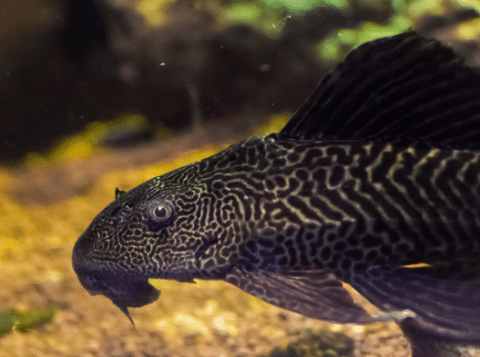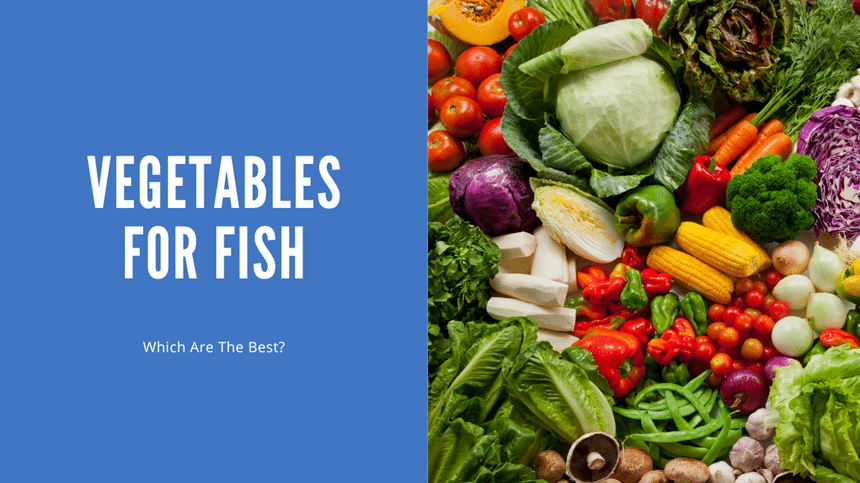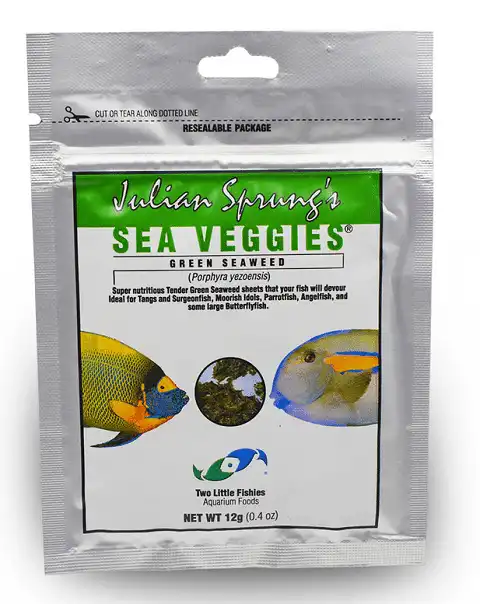Thank you for visiting! By the way… any links on this page that lead to products on Amazon and other stores/partners are affiliate links Aquarium Store Depot earns a commission if you make a purchase.
Tired of giving your fish the same food every day? Now imagine how boring it must be for them! Even for fish, a varied and well-balanced diet is a healthy diet.
Some fish rely on vegetation and algae in their natural habitats. While most fish foods excel at providing protein value, some of the more micro-nutrients received through fresh vegetables and other greens get forgotten.
Here’s how to safely prepare vegetables and other options available for widening your fish’s diet!
Key Takeaways
- Aquarium fish can be given an assortment of raw and frozen vegetables!
- Veggies are a great way to keep fish healthy by introducing vitamins and minerals that aren’t offered in typical fish food.
- Vegetables can be easily blanched and frozen for easy storage and long-term use.
- Some fish don’t like vegetables or have never been offered them, so algae wafers are a good alternative instead!
Vegetables For Fish – Which Are The Best Ones?
The best vegetable to feed fish (video from our official YouTube Video) is one that will withstand being submerged, at least for an hour or two. This vegetable should not start to disintegrate once a hungry fish starts to get to it. Luckily, a variety of vegetable options can be blanched and eaten by fish.
A good list of rotating veggies might look like:
- Broccoli
- Cucumber
- Zucchini
- Yellow squash
- Spinach
- Romaine lettuce
- Carrot
- Peas
- Nori (great for saltwater fish)
Not all fish will like all vegetables, so it might take some time to figure out which ones to include in your feeding rotation. Most hobbyists like to weigh small pieces down with a rubber band around a rock or a suction clip that attaches to the side of the glass.
Does Your Aquatic Pal Need Them?

Before we even start to discuss how to prepare fresh vegetables for your fish, you need to know if these foods would be similar to something that they would naturally come across in the wild. A carnivorous fish will probably not eat a cucumber, no matter how appealing it might look!
Most likely, you won’t be able to tell whether a fish is a carnivore, herbivore, or omnivore just by looking at it. There might be some signs, like sharp teeth or a sucker mouth, but even then, you can’t be fully sure. The best way to find out the natural diet of your fish species is by doing research about their natural habitat and hearing experiences from other hobbyists or your local aquarium store.
Once you’ve established the natural diet of your fish, you can begin catering to it. If it turns out that you have a herbivore fish, then you might start to supplement blanched vegetables into their diet.
Benefits of Veggies
There are many benefits to giving vegetables to fish. The main benefit is keeping fish healthy by supplementing vitamins and minerals that aren’t supplied through typical fish food1.

The other main benefit is enrichment. By now, you’ve probably noticed that your fish waits to be fed at the top of the aquarium anytime you walk by. Feeding time is what they look forward to! Adding veggies is a great way to make feeding time even more exciting and unpredictable while also adding variety and balance to your fish’s diet.
What Are Blanched Vegetables?
Simply put, blanching means submerging vegetables or fruits into boiling water for a short period, quickly removing them, and then placing them into a bowl of water with ice. This process only takes a couple of minutes but helps preserve the quality of the vegetable or fruit.
There are a few ways blanching achieves preservation. First, it inactivates enzymes that would otherwise begin to affect color, taste, and nutritional value over time. Similarly, blanching affects bacteria which would also cause the product to degrade faster.
Blanching is especially recommended when using vegetables as fish food due to insecticides and other residues. Unfortunately, many unknowns are used to treat food for consumption, so boiling them first reduces the chances of those chemicals entering the aquarium.
All in all, blanching fresh fruits and vegetables helps preserve them for longer and allows for easy freezing and storage. In the aquarium setting, most hobbyists only offer vegetables as fruits can be messy.
Can You Serve Them Raw?
Yes! Tropical fish can be fed raw vegetables. Blanching is recommended for hobbyists who want to keep vegetables on hand for future use. There are a couple of things that need to be considered, though.
As mentioned before, veggies are often treated with chemicals and other preservatives. These should be thoroughly washed off before being added to the tank. It is also likely that these pieces of raw vegetables will end up floating on the surface of the water, so it might take some extra effort to weigh them down.
How To Blanch Them

Almost any vegetable can be blanched, but not every blanched vegetable is good for the aquarium. Instead, certain hard vegetables, like broccoli, cucumber, zucchini, and peas, are some of the favorite feeding options for herbivores. This is because other vegetable matter can easily break down and start to affect water quality.
Vegetables with strong aromas, like brussels sprouts and onions, should be avoided as they can start to affect water conditions as well.
Buying Them
This might seem obvious, but you need to purchase your vegetables at the grocery store. Your local fish store will not have fresh vegetables! Now the question comes down to picking the right veggies for your fish.
Should you buy organic?
You definitely want to pick the best vegetables possible to feed your fish, and you should be mindful of what you’re putting in the aquarium. However, there is likely little difference between buying organic and using regular produce. The blanching process should hopefully remove any chemicals or additives in either option.
If you want to feed raw cucumber or another vegetable fresh from the rack, then it may be the better choice to buy organic.
Preparation
Depending on what type of vegetables you get for your fish, you might need to do some prep work. Think about how much food you want to give to your fish, for how long, and if you could use the leftovers for your own consumption!
Some vegetables, like zucchini, cucumber, and broccoli, will need to be cut up into manageable pieces. The goal should be to slice to expose as much of the soft, inside flesh as possible as fish will likely eat these sections first. For something like zucchini, slice each piece to be about 0.5 inches. Most other vegetables, like spinach and lettuce, can be split apart and fed more easily.
Now, you will want to consider how long you want to serve your fish this food. Fish eat as much as is available, so it’s not recommended to give it all at once. But you don’t want to be feeding the same thing for a month either! Prepare enough food for several feedings. Save some for blanching and save some for the dinner table.
Blanching Steps
Now it’s finally time to blanch the veggies. This process is straightforward and easy and almost impossible to mess up.
- Bring a pot of water to a rolling boil. The boiling water will activate those processes we talked about earlier!
- Fill a separate bowl with water and ice.
- Add the sliced vegetables to the boiling water.
- Allow them to boil for 1-3 minutes depending on the size of the slices.
- Remove the vegetables when they’re crispy. A crunchy vegetable needs more time and a mushy vegetable has gone too long.
- Add the veggies to the ice bath. Let them sit in the cold water for a minute or two.
- If you’re planning on freezing the vegetables, then wait until they’re completely cooled and dried. Then, store them in a plastic bag in the freezer.
Feeding Your Fish
When you’re ready to feed your fish, make sure to fully thaw the frozen vegetable matter. You may need to weigh it down with a rock or clip so that it doesn’t float.
Allow your fish to eat. It might take some time for them to find and understand that the vegetable matter is food. Snails are also naturally slow!
After a couple of hours, remove what remains of the veggies. If your fish and snails liked what they were given, you might just find vegetable skin left over.
How Often To Feed Vegetables?
How often you feed your fish fresh or frozen vegetables will depend on how many fish are present and their feeding habits.
If you have a larger tank with lots of tropical fish, shrimp, and snails, then you will need more food to make sure that everyone is getting fed. Always make sure to keep an eye on uneaten food and remove any pieces that could potentially get stuck in the back of the tank.
In general, fresh and frozen vegetables can be given one to two times a week to create a well-balanced diet.
Alternatives
While most aquarium fish enjoy a veggie snack every now and then, some fish simply don’t like vegetables, even if they’re herbivores.
It makes sense why a carnivorous fish might not eat veggies, but why wouldn’t a herbivore?
It is possible that your fish was never introduced to any foods other than flake or pellet foods. They might not know how to eat veggies! In cases like this, you can continue to offer your fish fresh vegetables until they take a nibble, or you could settle with a high-quality algae wafer or pellet.
For saltwater fish, consider a product like Julian Sprung’s Sea-Veggies
Sea veggies is an amazing product for Tangs, Rabbitfish, and Marine Angelfish. Fish go crazy for it. Clean and easy to feed!
FAQs
What vegetables can I feed my fish?
Tropical fish love most vegetables! But every fish will have its own appetite. The best veggies to feed fish include lettuce, peas, zucchini, and cucumber. These can be given raw or frozen as long as they are prepared and thawed before serving.
Can I feed my fish fruits?
While fruits can be blanched and stored for serving later, it’s not recommended to give fruits to fish. This is because fruit is high in sugar, which can easily start to affect aquarium water. Because of this, it’s generally recommended to only give fish vegetables.
How do I make prepared fish foods?
Feeding vegetables to fish is quick and easy! Depending on the type of veggie you’re giving, you may need to cut it up into small pieces. These pieces can then be washed and added directly to the tank or blanched and saved for later.
Why didn’t my fish eat vegetables?
Every fish is different and yours might not enjoy vegetables! Instead, you can supplement those vitamins and minerals with algae wafers or pellets.
How do I make prepared fish foods?
Feeding vegetables to fish is quick and easy! Depending on the type of veggie you’re giving, you may need to cut it up into small pieces. These pieces can then be washed and added directly to the tank or blanched and saved for later.
Why didn’t my fish eat vegetables?
Every fish is different and yours might not enjoy vegetables! Instead, you can supplement those vitamins and minerals with algae wafers or pellets.
Can saltwater fish eat vegetables?
Yes! Saltwater fish can also be given vegetables even though they’re unlikely to experience plant matter in their natural habitats. Because of this, saltwater fish are more likely to ignore vegetable offerings, but some might take a nibble.
Instead, saltwater fish can be offered different types of macroalgae and seaweed sheets. The most common type of veggie before Nori was popular was romaine lettuce.
Conclusion
Most fish love a selection of fresh veggies in addition to their staple fish flakes or pellet, though some fish don’t! These vegetables can be served raw or blanched and frozen for later use. Some options include lettuce, peas, carrots, and broccoli, but an algae wafer will substitute for more picky fish.
Keep in mind that feeding fresh veggies can be messy and not all fish will enjoy the offer! Uneaten food should be removed if left untouched after a couple of hours.
- About the Author
- Latest Posts
I’m thrilled that you found Aquarium Store Depot! Here you’ll find information on fish, aquariums, and all things aquatics related. I’m a hobbyist (being doing this since I was 11) and here to help other hobbyists thrive with their aquariums! I adhere to a high quality Editorial Process and Review products with real life field usage and practical analysis.






